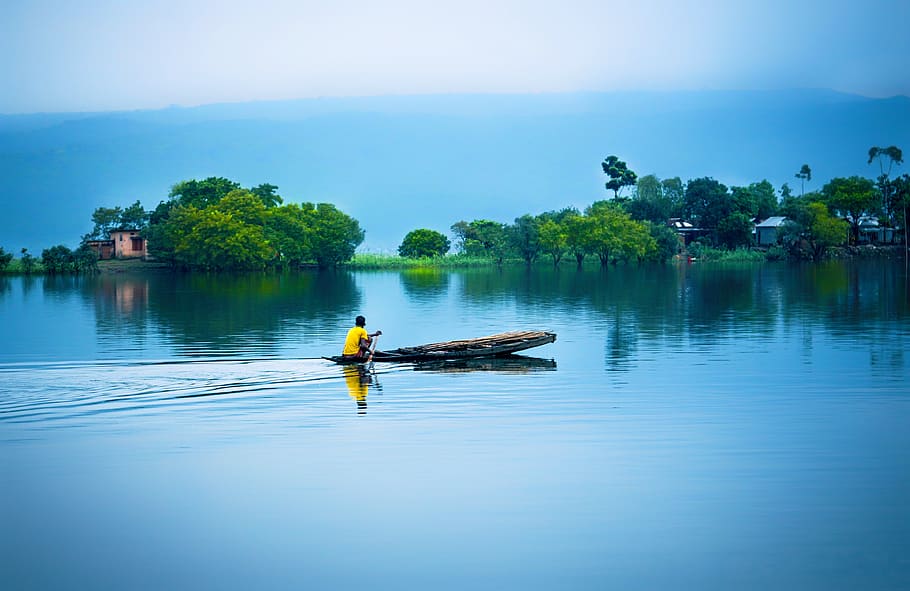The world’s water problems are alarming and will worsen in the coming years, but there’s a lot we could learn from the way other societies cope (or don’t).
Five doomed explorers in a sub-par submersible aren’t the only people who have had to adapt, one way or another, to the pressure of the world’s water problems around them lately. Across the globe, imperiled rivers, drought, flooding, and pollution threaten health, national and local economies, and even the continued habitability of populated regions. How societies adapt to these situations speaks not only to their resilience in the face of adversity, it may even signal how well we, as a species, are suited to a rapidly changing environment closing in on us.
It’s no secret that climate change will add to the world’s water problems in increasingly chaotic ways. In 2022, two billion people lacked access to safe drinking water, with half the global population facing water scarcity for at least one month of the year. Factor in a growing population, increased demand for industrial and agricultural use, the modern tendency to pollute water sources as if they weren’t necessary for life, and the capitalist manner of rationing scarce resources by cost rather than by need, and it’s not hard to see that water (and its relative abundance or lack) will be a major consideration for the foreseeable future.
So how are different people and places adapting, and what can we learn from them?
Bangladesh, a nation used to coping with watery abundance, has been open to change in ways that the rest of the world would do well to emulate. With little help from the wealthy countries most responsible for climate change, the people of Bangladesh are learning to communicate with each other and people upstream to insure that farmers can harvest their rice crops ahead of potentially devastating floods. They’re also using ancient technology to grow vegetable crops on floating beds, so that when the water rises, the plants rise too. The floating farms of Bangladesh and Mexico’s chinampa technology could be revived using local materials in flood-prone, watery areas around the world.
Floods are among the world’s water problems, but so is drought. Some farmers in southeastern Spain’s dry Murcia region, however, rely on recycled wastewater to irrigate their crops, a process that not only gives water a second use before returning it to the natural cycle, but also leaves it cleaner than it came in. About 98% of Murcia’s waste water is recycled this way (filling 15% of the region’s irrigation needs), compared to 9% of the wastewater recycled across Spain and a mere 5% throughout the EU. In a dry future, wasting water should be unconscionable. Toward this end, the Spanish government committed 1.4 billion euros (US$1.5 billion) to building wastewater recycling infrastructure around the country.
Texas may be the epicenter of heat right now, but even Canada is feeling the effects of warming and drought. In the prairie land of Alberta, the Texas of Canada, canola farmers are adapting to their slice of the world’s water problems through earlier planting (to ensure flowering before the heat of June), leaving more crop stubble and planting trees around their fields to trap winter’s snow (so the meltwater can soak into the fields), and breeding (or genetically modifying) drought-resistant seeds, but it’s uncler whether anything will help even crops that don’t require irrigation to survive in regions increasingly prone to dry conditions.
Unless the world abandons industrialism entirely (an option with a non-zero chance of happening), large scale pollution will continue to rank among the world’s water problems as well. At Khalifa University in the United Arab Emirates, researchers are pursuing higher technology to solve the problem of water pollution from the textile industry. Inspired by the sticky, protein-based “beards” that help mussels cling to rocks, they created a nanomaterial that combines a polymer with an eco-friendly solvent which, together, clean wastewater from the dyeing process. If it works under real-world conditions, the nanomaterial may have applications for other industries, from pharmaceuticals to mining (although it is worth noting that nanotechnology itself requires industrial infrastructure, and may not be practical everywhere). The world produces an estimated 95 trillion gallons of wastewater annually, equivalent to 41 years of drinking water for a planet’s worth of people, so being able to reuse it is key to mitigating shortages.
Other attempts at mitigation aren’t working as well, but still provide teachable lessons for those willing to learn.
In drought-stricken Uruguay, where water was declared a fundamental human right in 2004, the government has turned to desperate measures. Wells are being dug in parks in the Capitol, and the public water utility now mixes salty estuary water with the remaining fresh water supply to keep taps flowing. Those who can afford it have been buying bottled water, while those who can’t are stuck with the salty tap water that those with hypertension, kidney problems, or who are pregnant, have been told to avoid.

(It’s worth noting that the amount of money the world spends on bottled water could cover the cost of clean, safe tap water for everyone who currently lacks it.)
In London, England, the opening speaker at a 2019 water industry conference made a splash that caught national attention by announcing that swaths of the country, including London, would face significant water deficits by 2050 unless urgent action was taken.
One reason for the UK’s water crunch dates back to 1989, when the Thatcher government privatized what had been a national water system. Michael Howard, the minister responsible for water privatization, justified it by claiming that only private investment could save the vital resource, which competed with schools, hospitals, police, and other needs for scant public funding. Private investment, however, either comes from debt, which requires interest payments, or private capital, which needs to be enticed with the promise of dividends. Either way, someone needs to get wealthy from so vital a need as water, or it won’t happen. The solution of raising taxes on those who can afford to pay them (instead of borrowing that money and paying it back with interest) doesn’t seem to appeal to advocates for the wealthy.
Across the pond, there has been mixed success working through the legal system.
On one hand, 3M recently agreed to a settlement (which has yet to be approved) in which the chemical manufacturer will pay $10.3 billion over 13 years to assist municipalities in water testing and cleaning up PFAS contamination. Agreements have also been reached with DuPont and two other spinoff companies to pay $1.19 billion for PFAS cleanup. 3M further plans to stop manufacturing the “forever chemical” by the end of 2025. It sounds like a lot, but for a company that has known their products were toxic since the 1970s and persistently obscured that fact, it’s really not much. PFAS chemicals are found everywhere, from flesh to rain.
On the other hand, in the drought-stricken southwest United States, where states can’t agree how to share water from the Colorado river, new housing developments are restricted, thirsty fields may soon lie fallow, and giant data centers compete with humans for water, the Supreme Court ruled last week that despite an 1868 treaty, the United States doesn’t owe the Navajo Nation any assistance in accounting what water rights the US may be holding on their behalf so that any water due to them can be claimed by the tribe.
The Diné launched the 20-year-old case following long drawn out negotiations with the state of Arizona, in which the state continually used water rights as a way to gain other concessions from the tribe. Now they must either try negotiating with Arizona again, or hope Congress passes a law guaranteeing them access to water on the reservation land the government boxed them into over 150 years ago.
Humans have consumed so much groundwater that it changed the planet’s tilt. Major aquifers and reservoirs are emptying as industry, agriculture, and thirsty people work their way through the Earth’s small percentage of accessible, fresh water, and climate change is going to make it much harder in the coming years. Globally, demand for fresh water is expected to surpass supply by 40-50% as soon as 2030 – a mere seven years down the road. People will have to learn to adapt to the world’s water problems in more imaginative, effective ways, simply to stay alive. There’s a lot we can learn from the ways that other societies, across place and time, have managed their resources.
In the end, though, there’s one adaptation that is never going to work: killing the messenger.
Related: Colorado River States to Face Reckoning


Join the conversation!